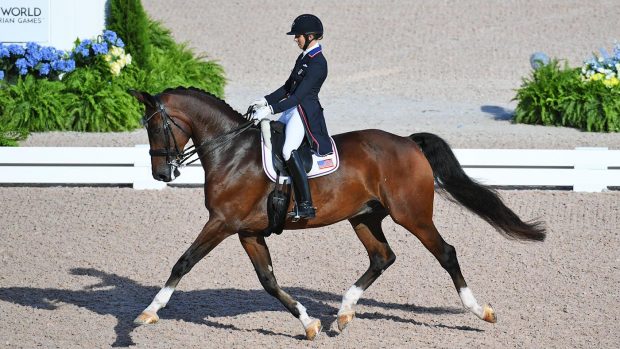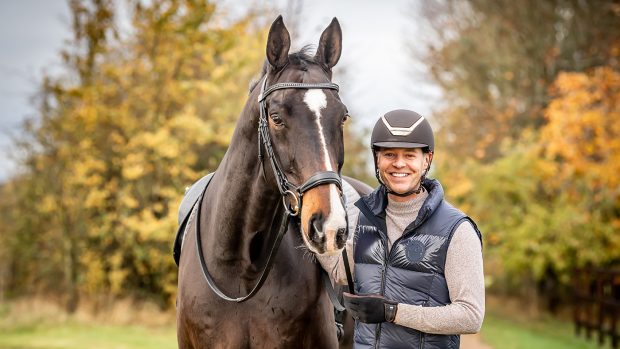The eight World Equestrian Games disciplines come together at one venue once every four years for the joint world championships as the world’s best horses and riders battle for both individual and team glory.
The next World Equestrian Games (WEG) are being held at Tryon, in North Carolina (11-25 September 2018).
World equestrian games disciplines
- Showjumping
- Dressage
- Eventing
- Para dressage
- Driving
- Endurance
- Vaulting
- Reining
World Equestrian Games showjumping
Showjumping is a sport in which horse and rider combinations tackle a set course of jumps leaving them all intact, often in the fastest possible time against the clock. The showjumping competitions in Tryon are open to both individuals and teams. The showjumping competition is in three parts. The team competition is decided after the first two competitions. The top 25 horse and rider combinations go forward to the individual final, which is run over two rounds of jumping. Find out more…
World Equestrian Games dressage
Dressage has been described by the layman as the sport of the ‘dancing horses’ or ‘equine ballet’. It involves horses performing a pre-set pattern of movements in respond to the rider’s aids or signals. At the World Equestrian Games, there are both team and individual competitions, which take place across the grand prix, grand prix special and grand prix freestyle. The first two competitions follow a set pattern. In the freestyle set movements have to be performed, but they can be done in any order and at any place in the arena, while being set to the rider’s choice of music. The team result is decided after all riders have taken part in the grand prix. There are two sets of individual medals; one for the grand prix special and another for the grand prix freestyle. Find out more…
World Equestrian Games eventing
Eventing is a type of triathlon for equestrians. Each horse and rider takes part in all three phases of the competition: dressage, cross-country and showjumping. The sport has its history in the military and is designed to be a test of all-round horsemanship of the rider and the adaptability and training of the horse across the different sports. At the World Equestrian Games, there are both team and individual medals on offer. The dressage and showjumping are set at four-star (the top international level), while the cross-country is at three-star level. The sport is scored in penalties so the lowest score wins. Find out more…
World Equestrian Games para dressage
Para dressage (dressage for disabled riders) has been part of the World Equestrian Games since 2010. Para riders are graded in one of five sections according to their disability, with grade I being the most impaired and grade V the least. There are both team and two sets of individual medals available at the World Equestrian Games. Teams are made up of either three or four riders per nation, with each team including at least one grade I, II or grade III rider. Teams cannot include more than three riders in any one grade. Find out more…
World Equestrian Games driving
The combined driving competition at the World Equestrian Games is another equestrian triathlon, similar to eventing, but using teams of four horses harnessed to a carriage instead of a single horse and rider going over jumps. The three phases are: dressage, marathon (an endurance test combining roads and tracks with a final phase including obstacles – similar to the old “long-format” endurance cross-country test in eventing), and cones. This is another competition that is scored in penalties so the lowest score wins. Find out more…
World Equestrian Games endurance
The sport of endurance involves horses being ridden over long-distances in a competitive environment. Maintaining the horses’ welfare is key to the sport of endurance riding with horses having to pass vet checks both during and at the end of rides. The first horse and rider past the finishing post are not crowned the winner until the horse has passed the final vet check. The endurance competition at the World Equestrian Games takes place over a distance of 160km. Find out more…
World Equestrian Games vaulting
Vaulting can be described as gymnastics on a moving horse. The horse is lunged in canter on a circle at least 15m in diameter while the vaulter(s) performs various moves, jumps and lifts. There are five competitions in the WEG vaulting competition: male and female individual; pas de deux (two vaulters); squad (seven individuals, with up to three allowed on board the horse at one time); and a team (all from one country) where the results of three of the previously mentioned competitions are added together. A team result must include at least one squad or pas de deux. Find out more…
World Equestrian Games reining
Reining is a form of Western riding that shows off the athletic ability and movements commonly used by ranch-type horses who are used to work cattle. At the World Equestrian Games each rider has to ride one of 10 approved patterns in an arena. There are around seven movements that must be shown including 360-degree spins, sliding stops, flying changes, small and slow canter circles plus bigger, faster canter circles. Riders only have one hand on the rein and the contact is loose most of the time — their seat does the majority of the work — and each movement must be smooth and controlled. Find out more…
.
Stay up to date with all the action from the World Equestrian Games here on Horseandhound.co.uk




